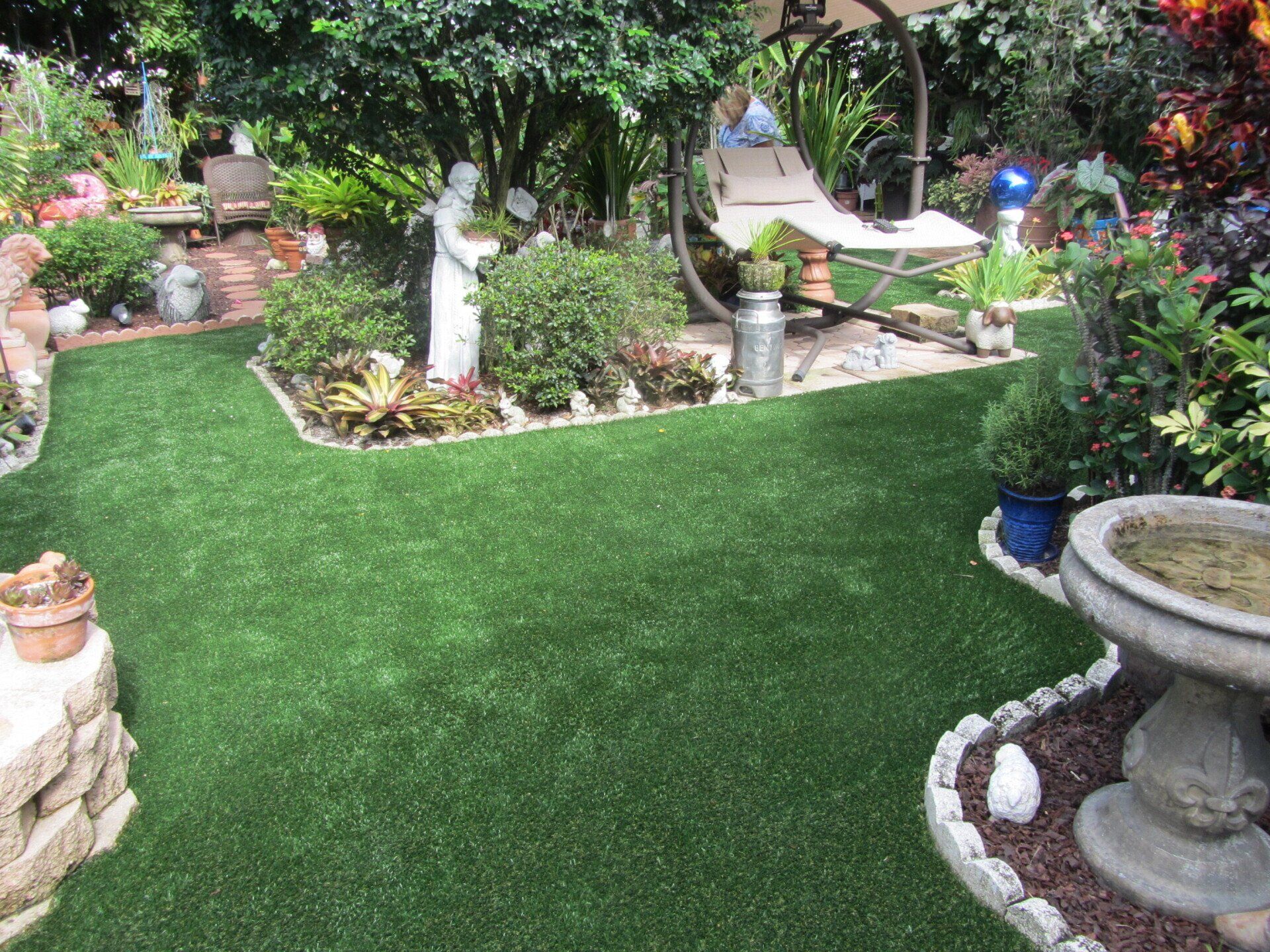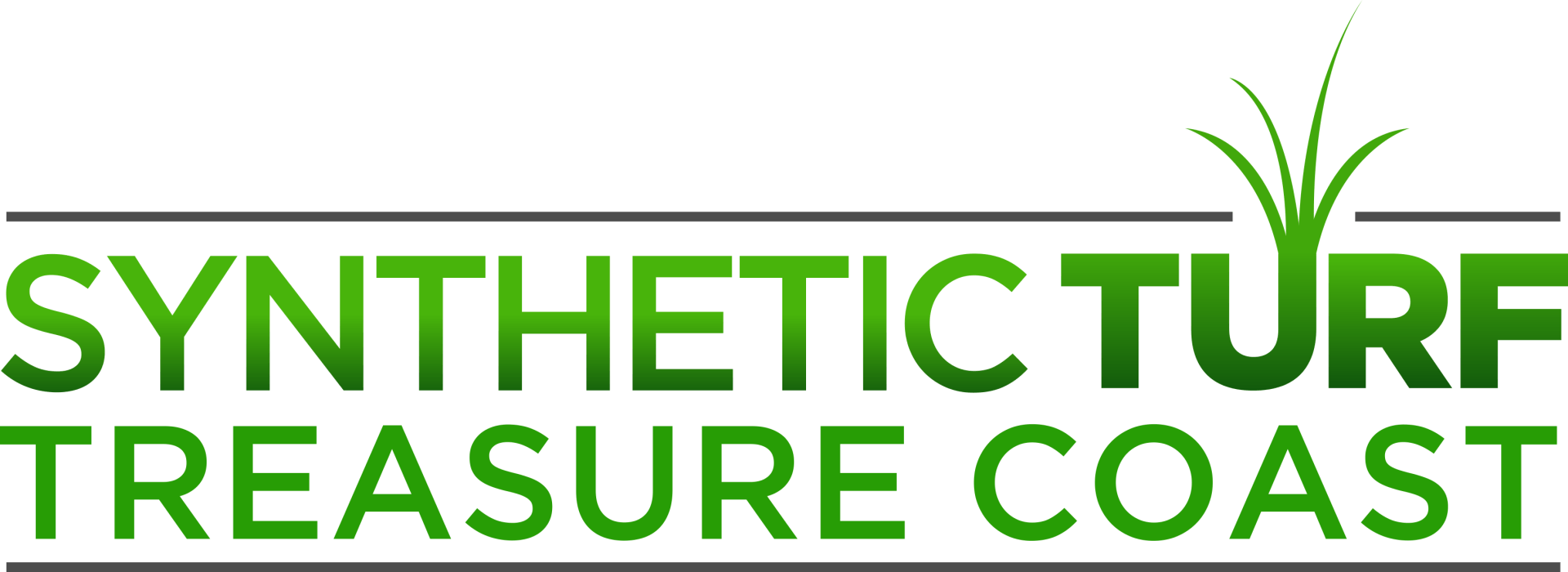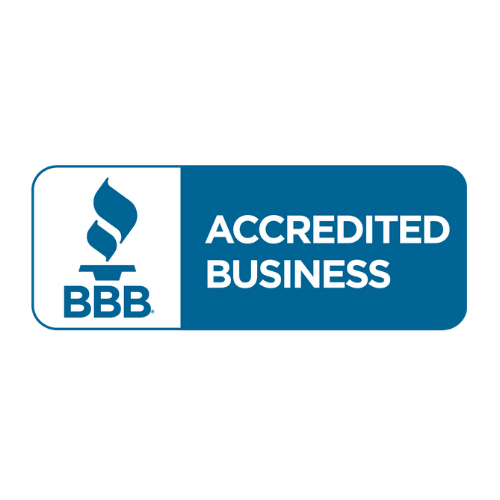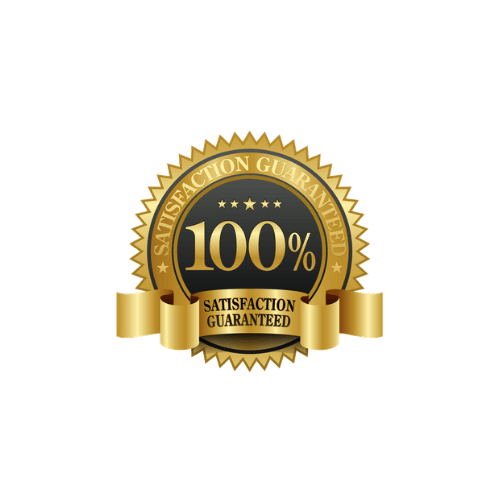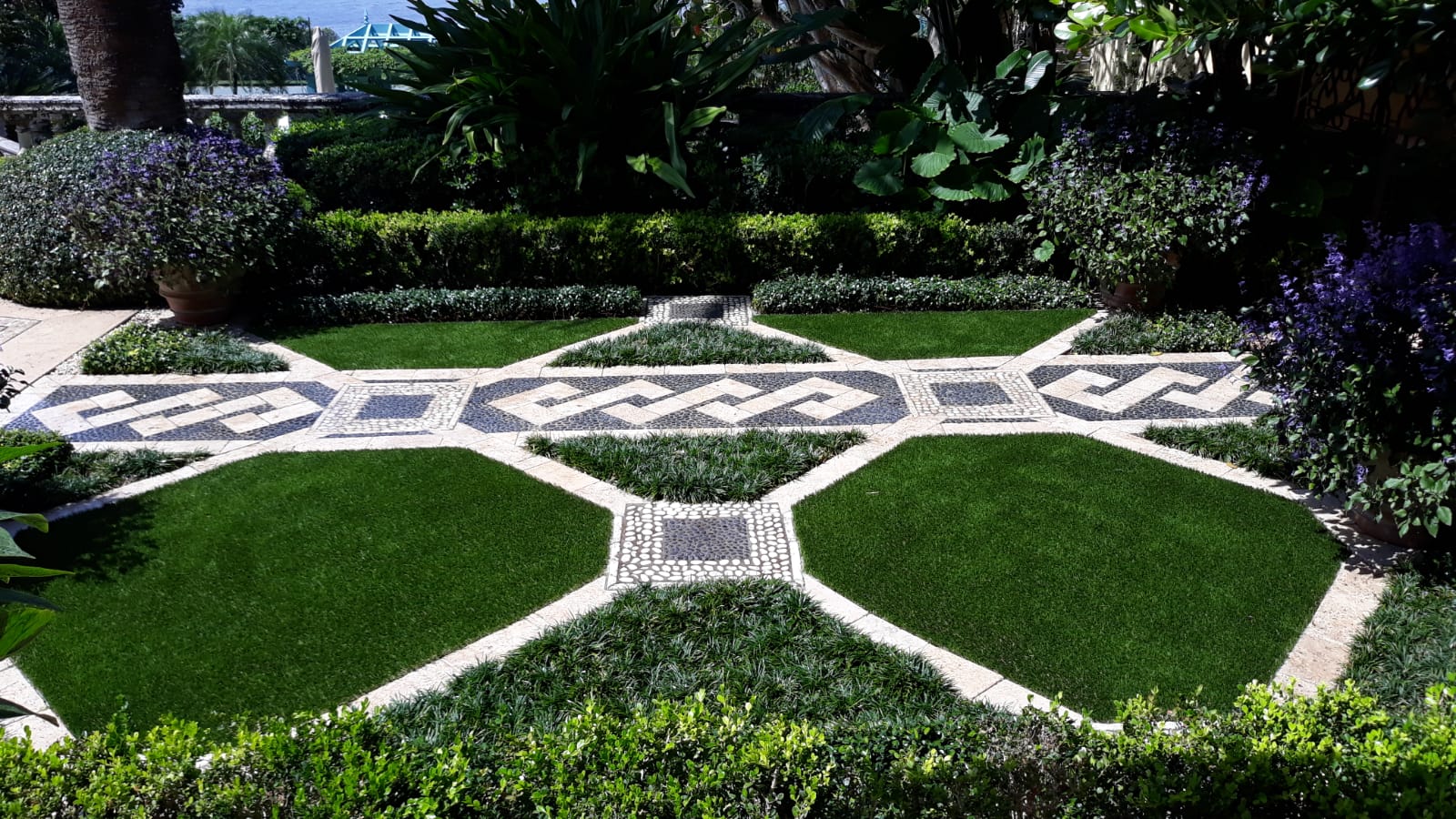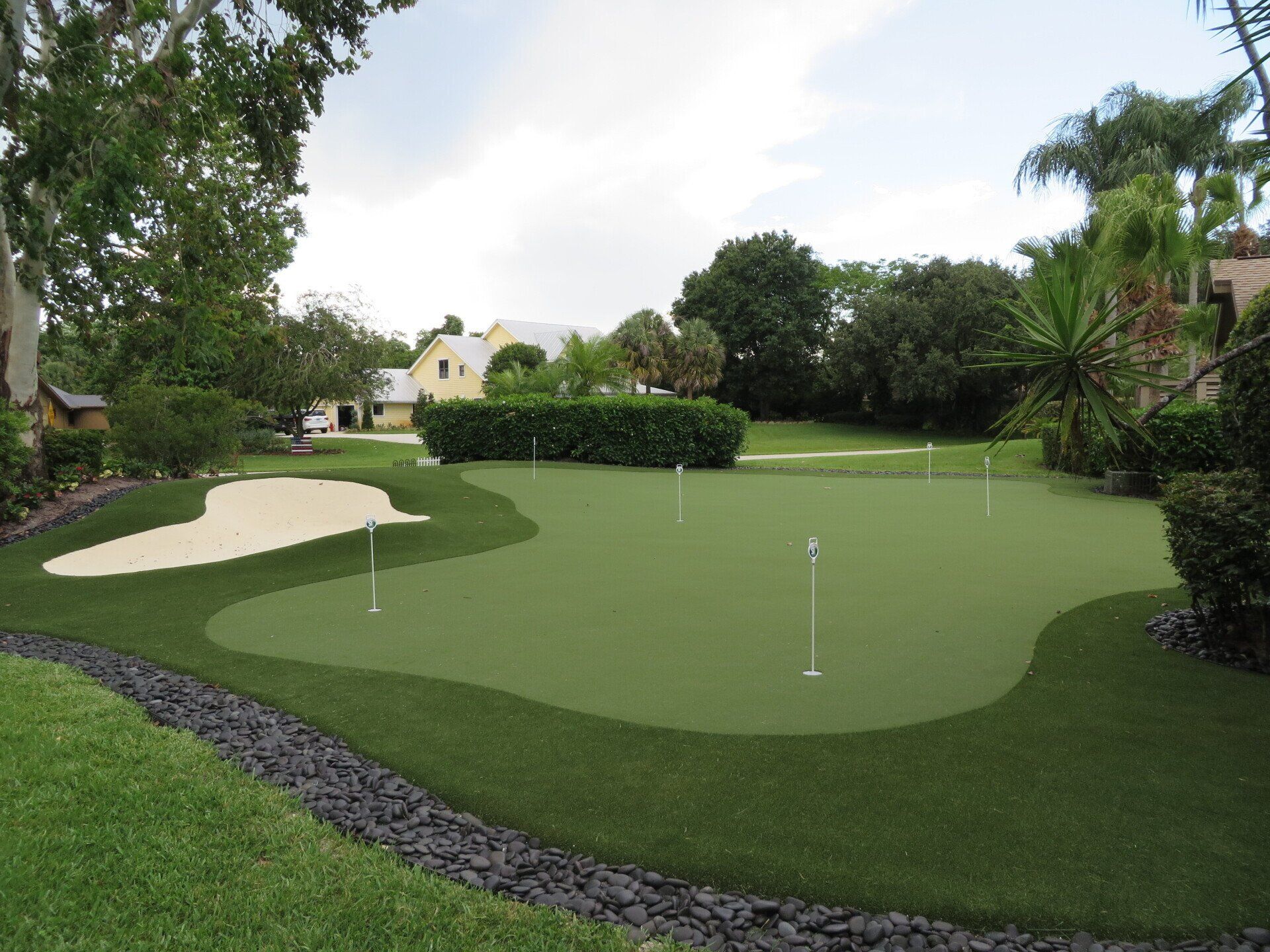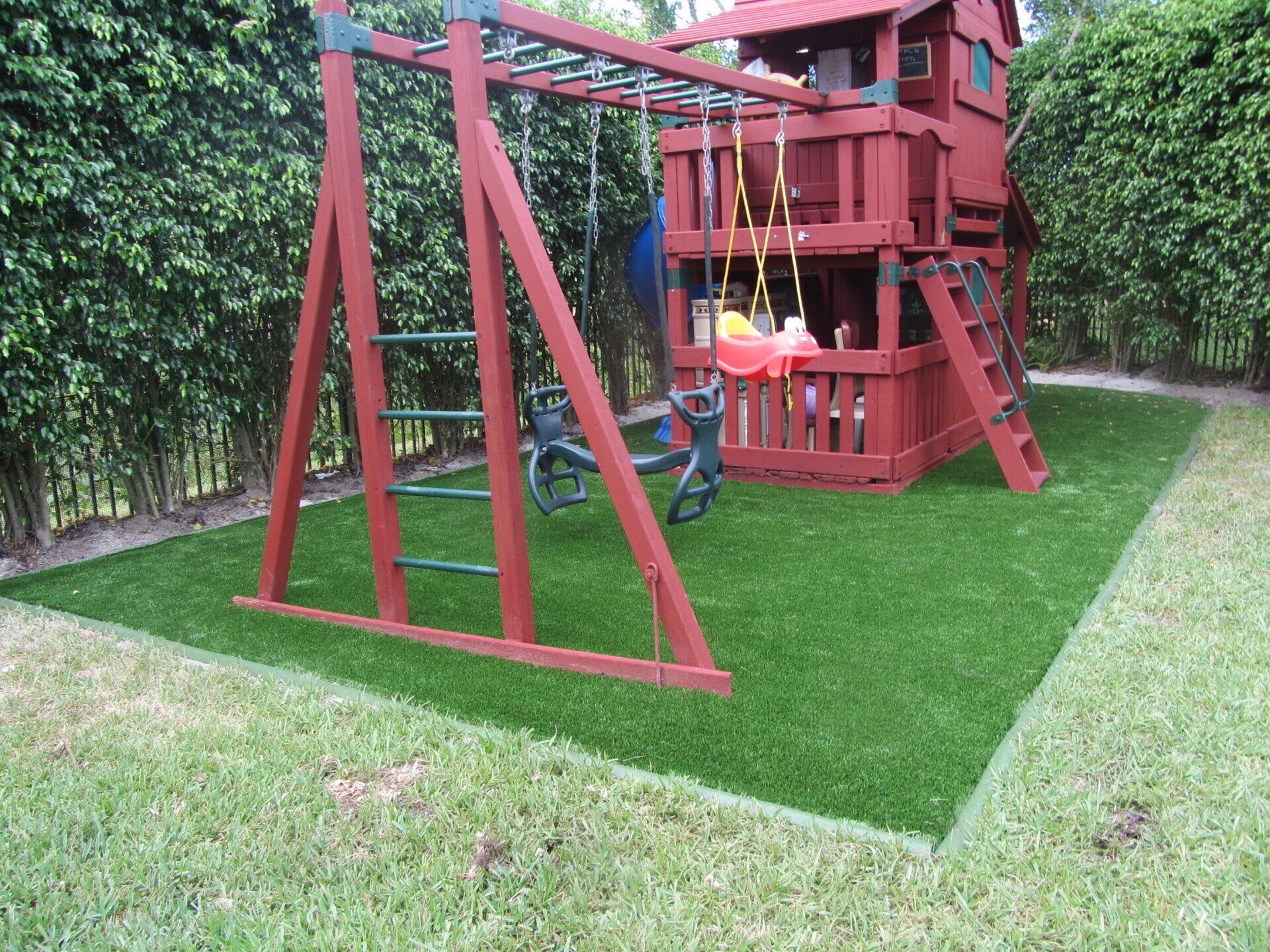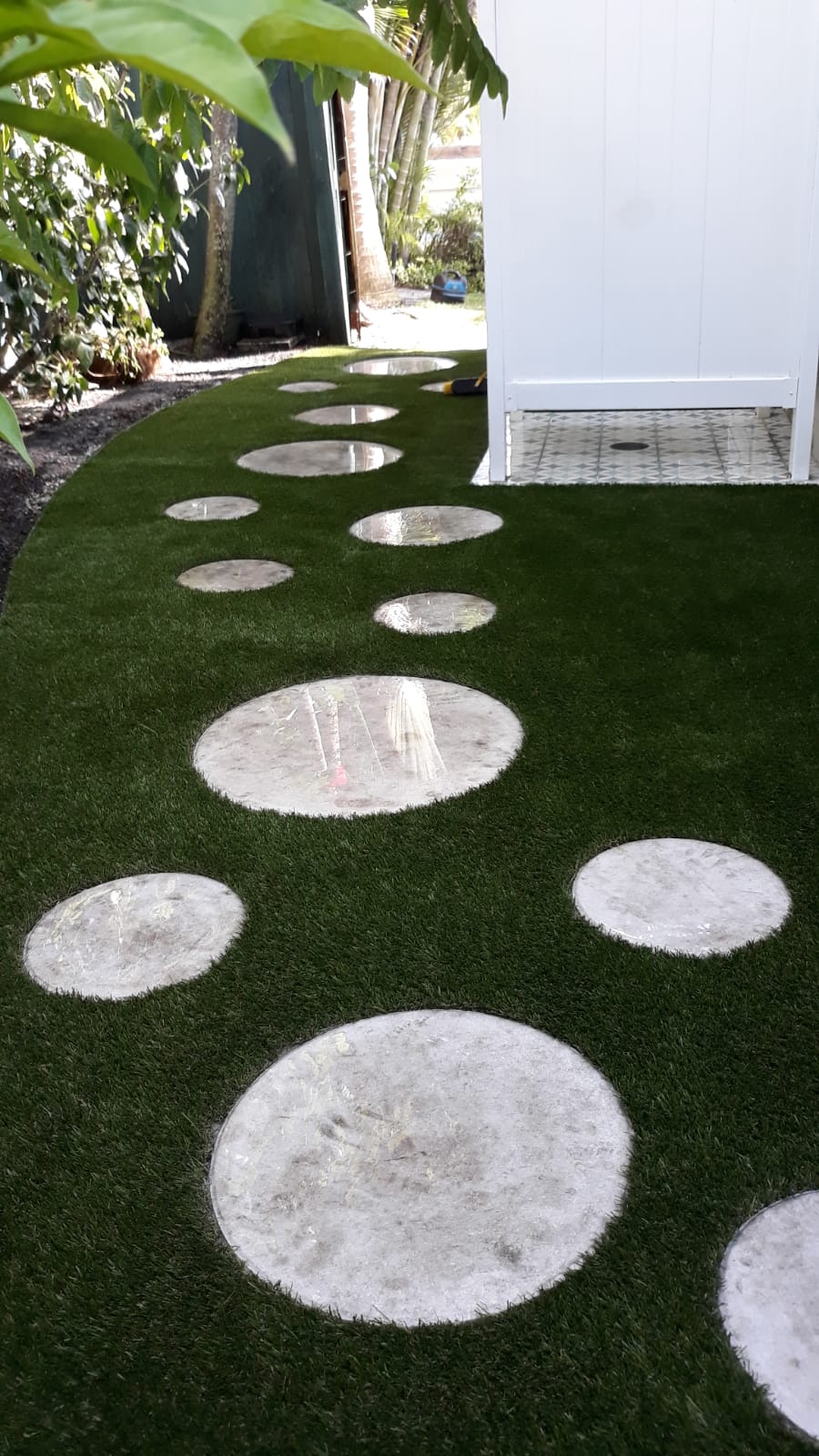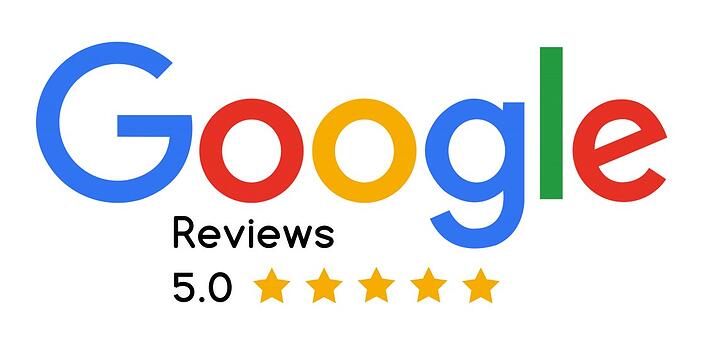Since 2001
The Poolside Revolution: How Artificial Turf is Redefining Backyard Living

The Allure of a Poolside Oasis: Why Artificial Turf is Redefining Backyard Living
The vision of a perfect backyard pool area often includes a lush, green lawn that complements the sparkling blue water. Traditionally, homeowners have faced a difficult choice: a soft, natural lawn that is difficult to maintain and suffers from heavy foot traffic, or a hard, durable surface like concrete or pavers that can be hot, unforgiving, and visually uninspiring.
A third option, artificial turf, has emerged as a modern solution that is redefining this classic choice by marrying the aesthetic of a natural lawn with the robust functionality of a hardscape.
This engineered surfacing material is not merely a replacement for natural grass; it is a high-performance decking material designed to compete directly with hard surfaces on critical metrics like safety, durability, and drainage.
With 20 years experience, we are one of the best artificial turf installers near you in Palm City, FL! Give us a call today to get a free quote.
Your Turf, Our Care
Unpacking the Core Benefits: Function Meets Form
Artificial turf's primary appeal lies in its ability to address the most significant pain points of traditional poolside surfaces.
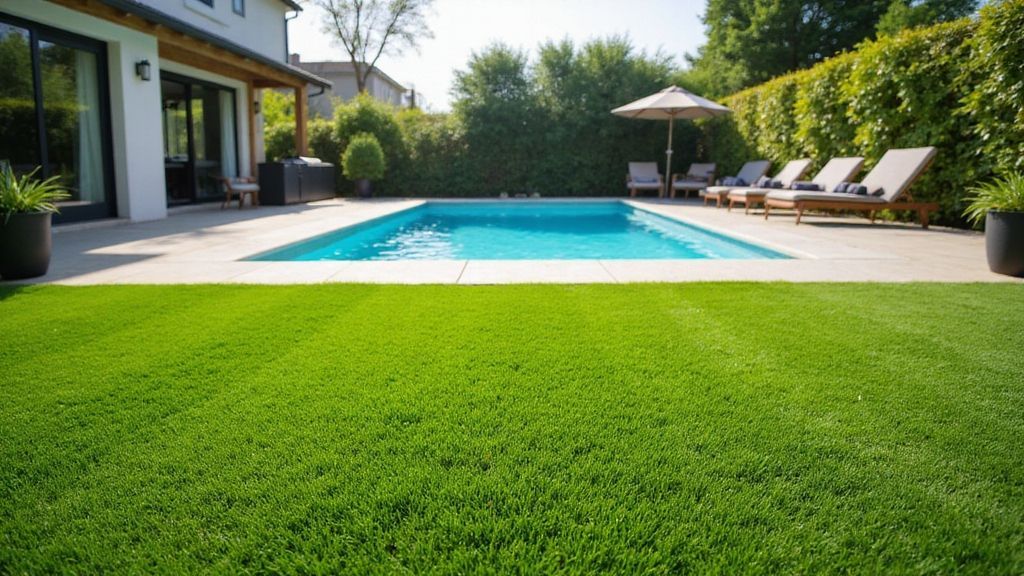
Safety First: The Slip-Resistant Advantage
Safety is a paramount concern around any pool. Wet concrete and pavers can become dangerously slick, leading to falls and serious injuries. Artificial turf provides a safer, non-slip surface with enhanced traction, which is a crucial advantage for families with children and pets. The surface also offers a softer landing in the event of a fall, significantly reducing the impact compared to a hard, unforgiving surface like concrete. The long-standing rule of "no running" around the pool exists for a reason, but artificial turf helps mitigate the risks that arise when accidents inevitably happen.
The Drainage Revolution
Proper drainage is essential for a clean, safe, and functional pool area. Unlike natural grass, which can become a muddy, waterlogged mess, or concrete, which allows water to pool on the surface, modern artificial turf is engineered for superior water flow. Products with fully permeable backing, which feature micro-pores throughout the entire surface, can drain water exceptionally fast—some at rates of up to 800 inches per hour. This prevents the accumulation of standing water and mud after a heavy rain or pool splash, ensuring the area remains dry, stable, and visually appealing.
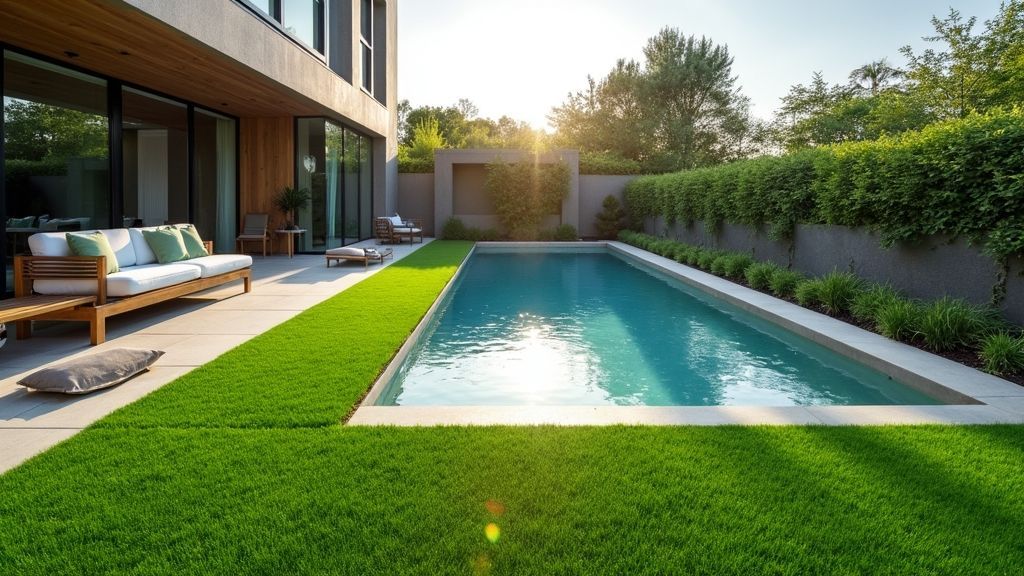
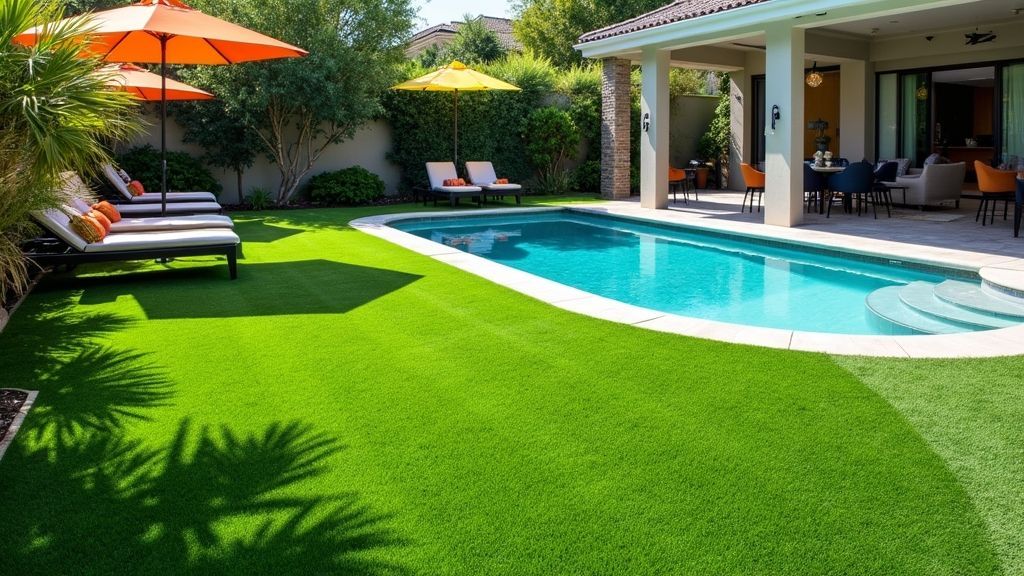
A Pristine, Ever-green Aesthetic
The vibrant, manicured look of artificial grass is a key selling point. It maintains a lush green appearance year-round, regardless of weather conditions, direct sunlight, or heavy foot traffic. The struggle of keeping natural grass green in a pool environment, where chlorine and constant moisture can cause discoloration and patches, is completely eliminated. This consistent, pristine look provides a visually stunning backdrop for the pool at all times.
The Low-Maintenance Dream
A primary reason for the growing popularity of artificial turf is the dramatic reduction in maintenance. Homeowners can say goodbye to the time-consuming and labor-intensive chores of mowing, trimming, and fertilizing. This frees up valuable time that would have been spent on yard work, allowing families to spend more time simply enjoying their pool and outdoor space.
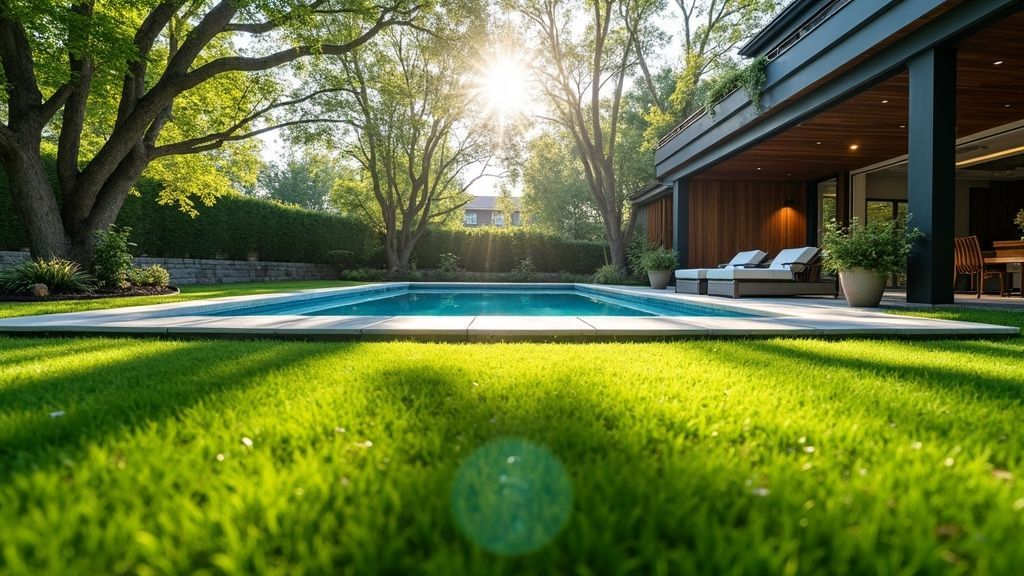
The Ripple Effect: Environmental, Financial, and Health Benefits
The advantages of artificial turf extend beyond aesthetics and function to include a range of environmental, financial, and health benefits that reinforce its value.
Weekly & Bi-Weekly Quick Care
- Water Conservation: Water usage is a major concern for many homeowners, especially in drought-prone areas. Landscaping and grass watering can account for a significant portion of a household's water consumption. By eliminating the need for irrigation, artificial turf can save thousands of gallons of water annually, leading to noticeable reductions in monthly water bills while also making a positive environmental impact.
- Chemical-Free Living: Artificial turf creates a clean, self-contained ecosystem around the pool that benefits both the landscape and the water. Natural grass often requires the application of chemical pesticides, herbicides, and fertilizers, which can be hazardous to people and pets. These chemicals can also be carried into the pool on bare feet or through rainwater runoff, disrupting the pool's delicate chemical balance. Conversely, pool chemicals like chlorine can be equally destructive to a natural lawn, causing discoloration and death. Artificial turf is specifically designed to be resistant to these harsh chemicals and UV rays, preventing fading or deterioration and creating a mutually protected environment. This eliminates chemical cross-contamination in both directions.
- Goodbye Mud and Bugs:
The absence of soil means the end of mud and dirt. Swimmers and pets can exit the pool and move onto the turf without tracking mud or grass clippings into the water or the house. Additionally, artificial turf is not an edible food source for insects, which helps to naturally repel bothersome pests like fleas, ticks, and mosquitoes, making the poolside area a more comfortable and hygienic space.
A Reality Check: The Critical Drawbacks and Smart Solutions
While artificial turf offers a host of compelling advantages, a thorough understanding of its limitations is essential for an informed decision. The most significant challenges for homeowners often revolve around the initial investment and the potential for heat retention in direct sunlight.
- The Upfront Investment: The initial installation cost of artificial turf is often the most substantial barrier for homeowners. The average cost for a professional installation can range from $10 to $19 per square foot, which includes materials, labor, and a properly prepared sub-base. This is significantly higher than the upfront cost of natural grass or basic concrete. However, this initial expense is often offset by significant long-term savings on water bills and maintenance costs. Most artificial turf installations will pay for themselves within 4-7 years.
- Heat Retention in Direct Sun: As a synthetic material, artificial turf absorbs and retains heat, becoming uncomfortably hot to the touch in direct sunlight, particularly in warm climates. On a hot day, the surface temperature of artificial turf can be similar to that of blacktop pavement and can reach temperatures above 150° F (65.6° C). This can make walking barefoot on the surface a challenge and is a critical consideration for a poolside area where bare feet are common.
- Innovative Solutions to Beat the Heat: Fortunately, the artificial turf industry has developed a range of technologies to mitigate the heat retention issue. These solutions are often integrated into the product itself or the installation process, and understanding them helps to justify the higher initial cost as an investment in a more comfortable and functional product.
Advanced Cooling Technologies
Modern cooling solutions employ a layered approach to heat management.
- Heat-Blocking Infills: Specialized infills like HydroChill, T°Cool, and Zeofill are designed to absorb and retain moisture. When wet, these infill granules release a cooling effect as the water evaporates. It is important to note that these infills require activation by water (e.g., a simple hosing down) to be effective, which makes them particularly well-suited for a poolside environment where water is readily available.
- Blade Shape and Material: The physical design of the turf blades themselves can play a role in temperature regulation. Technologies like "CoolFlo" and "Shine Block" utilize unique blade shapes, such as W or Wave, that reduce the reflective quality of the fibers and improve airflow to help dissipate heat passively.
- Color and Density: Lighter-colored turf and products with hollow blade technology or a lighter face weight can also help to reduce heat absorption, keeping the surface cooler.
- Practical Shading and Misting:
In addition to advanced products, simple strategies can be highly effective. Incorporating shade from strategically placed trees, awnings, or shade sails can block direct sunlight and create cooler resting spots. Furthermore, a quick spray with a garden hose can provide instant relief, dramatically reducing the surface temperature for several hours.
Other Considerations: Longevity, Materials, and Maintenance
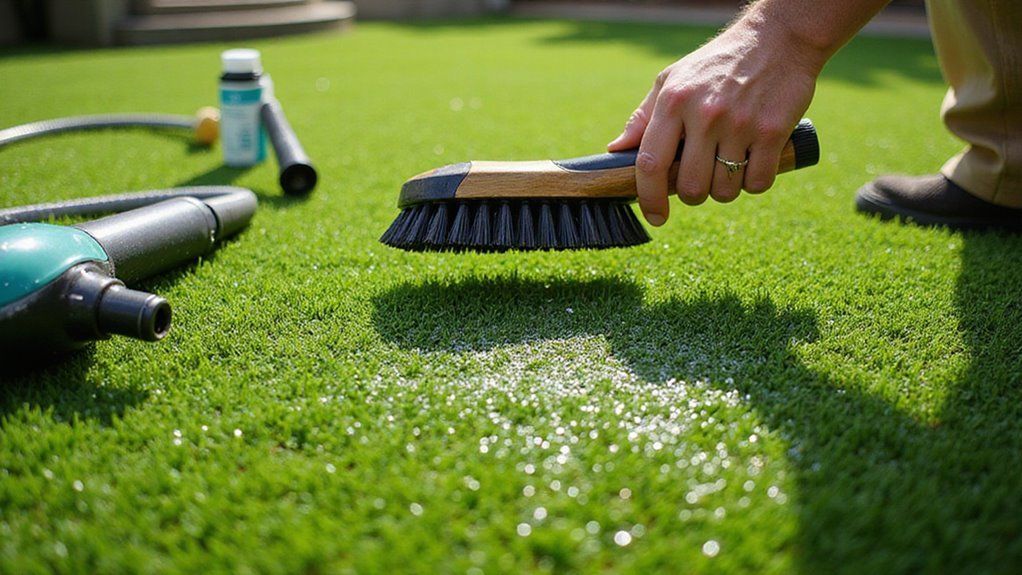
- Environmental Footprint: The synthetic nature of artificial turf means it is not biodegradable and will contribute to landfill waste at the end of its lifespan. However, this must be weighed against its exceptional durability and longevity, with many products lasting 15 to 20 years or more. Its long lifespan and the fact that it eliminates the need for water, pesticides, and fertilizers are also key environmental considerations.
- Surface Feel and Hardness: While artificial turf is significantly softer and more forgiving than concrete or pavers, some products may still feel harder than natural grass. This can be a factor for homeowners who plan to use the area for lounging or playing. However, high-quality polyethylene-based products offer a soft, realistic texture that is comfortable for bare feet.
- Maintenance of Cleanliness:
The "low-maintenance" promise does not mean "no-maintenance." Artificial turf requires occasional care to remain in top condition. Debris like leaves and dirt can accumulate in the fibers and must be removed with a broom or leaf blower. For pet owners, pet waste must be promptly removed, and the area rinsed to prevent odors.
Decoding the Details: A Buyer's Guide to Choosing the Right Turf
Selecting the right artificial turf for a poolside area is a nuanced process. The performance, longevity, and aesthetics of the final product are less about its surface appearance and more about its underlying technical specifications. Homeowners must look beyond the color and pile height to the critical, often unseen, features that make a product "pool-ready."
The most critical factor in choosing the right turf is the material from which it is made. The three main types are polyethylene, nylon, and polypropylene, and each has distinct properties that impact performance in a poolside environment.
- Polyethylene (PE): This is the preferred choice for pool areas. Polyethylene-based turf is praised for its soft, realistic texture and its exceptional balance of durability and comfort. It offers strong resistance to both UV rays and chlorine, which is vital for preventing discoloration and deterioration from constant sun exposure and splashes from the pool.
- Nylon: While nylon is the most durable and resilient material, it is not recommended for poolside use. Its primary drawback is that it retains significant heat in direct sunlight and lacks the soft texture of other materials, which can lead to uncomfortable "turf burn" on skin.
- Polypropylene (PP): This is the softest and most economical material, but it is also the least durable and most prone to wear and tear. It tends to flatten and break down easily under heavy foot traffic, making it a poor choice for a busy poolside area.
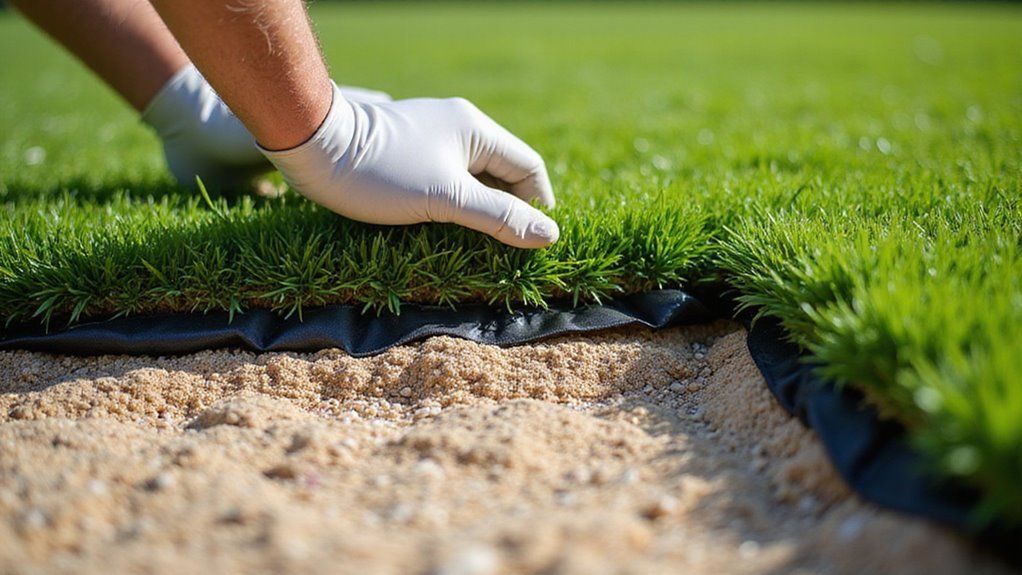
| Feature | Polyethylene (PE) | Nylon | Polypropylene (PP) |
|---|---|---|---|
| Durability | Strong, Long-lasting | Most Durable, Resilient | Least Durable, Prone to Wear |
| Softness | Soft, Realistic Texture | Not Soft | Softest |
| Heat Retention | Low-to-Moderate | High | Low-to-Moderate |
| Chlorine/UV Resistance | Excellent | Very Strong | Susceptible to UV Damage |
| Best Use Cases | Pool Decks, Lawns, Pet Areas | High-Traffic, Commercial | Decorative, Low-Traffic |
The Backbone: Backing, Drainage, and Installation Prep
The performance of the turf is intrinsically linked to its backing and drainage system.
- The Crucial Role of Permeable Backing: For a poolside application, it is strongly recommended to choose a product with a 100% permeable backing rather than one with hole-punched drainage. Fully permeable backing, with its micro-pores, allows for rapid water drainage, preventing water buildup, reducing the risk of microbial growth, and ensuring the surface dries quickly.
- Pile Height and Density: The pile height refers to the length of the grass fibers. For high-traffic areas like a pool deck, a shorter pile height (1.5 inches or less) is the most practical choice. It holds up better to constant activity, drains more efficiently, and is easier to clean than a taller, more luxurious pile.
- Infill Selection: Infill is a granular material spread between the turf fibers. Its purpose is to help the blades stand upright, provide cushioning, and act as a ballast to keep the turf in place. Recommended infill types include silica sand and specialized odor-reducing infills like Zeofill, which also helps prevent microorganism growth. For hot climates, a cooling infill like HydroChill or T°Cool is a highly effective option.
Key Features for Poolside Performance
- UV and Chlorine Resistance: Products specifically designed for pools have been treated to resist fading and deterioration from prolonged sun exposure and harsh pool chemicals. This ensures the turf's color and structural integrity will last for years.
- Antimicrobial Additives: Some turf products come with built-in antimicrobial additives that prevent the formation of mold, mildew, and bacteria in the constantly wet environment around a pool. This is particularly useful for maintaining a clean and hygienic surface.
- Blade Shape Technology: Modern blade shapes, such as W or Wave, are designed not only for aesthetics but also for performance. They can help to enhance light reflection and improve airflow to passively dissipate heat, providing a more comfortable surface.
The Ultimate Decking Showdown: Turf vs. Concrete, Pavers, and Natural Grass
| Feature | Artificial Turf | Natural Grass | Concrete | Pavers |
|---|---|---|---|---|
| Initial Cost | High | Low | Low | High |
| Long-Term Maintenance | Low (Rinsing, Brushing) | High (Mowing, Watering) | Low (Power Washing, Sealing) | High (Re-leveling, Weeding) |
| Safety | High (Non-slip, Soft Fall) | Moderate (Muddy, Uneven) | Low (Slick When Wet, Hard Fall) | Moderate (Can Shift & Create Trip Hazards) |
| Heat Retention | Moderate (Cooling Options) | Low | High (Causes Burns) | Moderate-to-High |
| Drainage | Excellent (Fully Permeable) | Poor (Waterlogging, Mud) | None (Water Runs Off) | Semi-Permeable |
| Durability | High (15-20+ Years) | Low (Traffic, Chemicals) | High (Cracks Inevitable) | High (Can Shift, Weeds Grow) |
| Aesthetics | Lush, Manicured, Year-Round | Natural, but Patchy Near Pool | Utilitarian, Can be Stamped | Versatile, but can Look Tired |
Comparative Analysis of Poolside Decking Materials
- Artificial Turf vs. Natural Grass: The most direct comparison is between artificial and natural grass. The primary advantage of artificial turf is the elimination of all the problems associated with a natural lawn near a pool. It requires no mowing, watering, or chemicals, and it prevents the mud and grass clippings that can be tracked into the pool. The aesthetic is consistently flawless and vibrant all year, a stark contrast to the patchy, sun-scorched, and chlorine-damaged look of a natural lawn. While natural grass has a low initial cost, it is a high-maintenance option that is ill-suited for the specific demands of a poolside environment.
- Artificial Turf vs. Concrete: The most compelling argument for artificial turf is often made against hardscapes like concrete. While concrete is durable and has a low initial cost, it presents significant safety and comfort issues. It becomes extremely slick when wet and can get hot enough to cause third-degree burns on a sunny day. In contrast, artificial turf offers a softer, non-slip surface that stays cooler than concrete, especially with modern cooling technologies. It provides a more visually appealing, natural look that won't crack or require patching over time.
- Artificial Turf vs. Pavers:
Pavers offer more design flexibility and visual interest than poured concrete, and they are semi-permeable, allowing for better drainage. However, their initial cost is high, and their long-term maintenance can be demanding. Pavers are susceptible to shifting due to freeze-thaw cycles or root growth, which can create trip hazards. They also require regular re-leveling, re-sanding of joints, and ongoing weed control. Artificial turf is a softer, safer, and lower-maintenance alternative that provides excellent, fully permeable drainage and won't shift or create trip hazards.
The Path to Perfection: A Glimpse into the Installation Process
The long-term performance and durability of artificial turf are directly dependent on the quality of its installation. A "low-maintenance" product can become a constant problem if shortcuts are taken during the crucial sub-base preparation phase.
The Critical First Steps: Preparing the Sub-Base
The sub-base is the foundation of the entire system and is essential for both stability and drainage. The process begins with the removal of existing grass, soil, and roots to a depth of 2 to 4 inches. The ground is then graded to create a slight slope (approximately 1-2%) away from the pool, ensuring that water flows away from the structure and into the surrounding landscape. A permeable base material, such as crushed stone or decomposed granite (DG), is then laid down in a 2- to 4-inch layer. This layer provides both a stable foundation and a medium through which water can drain freely. The base is then compacted using a vibrating plate compactor to create a dense, rock-solid surface that will not shift or settle over time.
Laying, Seaming, and Securing the Turf
Once the sub-base is prepared, the turf is unrolled and carefully trimmed to fit the precise contours of the pool area. For larger projects, multiple panels of turf must be joined seamlessly. This is done by laying specialized seaming tape along the edges where the panels will meet and applying an adhesive before carefully pressing the panels together. The final step is to secure the perimeter of the turf with non-corrosive nails or pins, ensuring that the entire surface is held firmly in place and will not shift with use.
DIY vs. Professional Installation: A Crucial Decision
While a DIY installation may seem appealing for its potential cost savings and personal satisfaction, professional installation is the recommended approach for poolside projects. The complex requirements of proper grading, base preparation, and seamless cutting and seaming are difficult to get right without specialized tools and expertise. An improper DIY installation can lead to drainage problems, visible seams, and premature wear, all of which can be costly to repair. A professional installer can ensure a flawless result and often provides a warranty, which can be voided by a DIY installation.
With over 50+ years combined experience, Synthetic Turf Treasure Coast can professionally install your turf according to industry standards.
Keeping It Flawless: Essential Maintenance and Cleaning for a Poolside Turf
Artificial turf is a low-maintenance solution, but it is not a no-maintenance one. A simple, consistent cleaning routine is essential for preserving its beauty and longevity, especially in a poolside environment where it is exposed to unique challenges.
The Poolside Cleaning Routine
- The Weekly Rinse: The most important part of poolside turf maintenance is a regular, weekly rinse with a garden hose.30 This simple step is critical for washing away chemical residue from chlorine and saltwater, as well as mineral deposits, before they can build up. Prolonged exposure to these chemicals can cause the turf fibers to dry out, lose their softness, and even discolor.
- Removing Debris: Regularly removing debris like leaves, dirt, and dust is necessary to keep the turf looking neat and prevent buildup. This can be accomplished with a stiff-bristled broom or a leaf blower. Metal rakes should be avoided as they can damage the fibers.
- Occasional Brushing: Over time, constant foot traffic can cause the turf fibers to flatten. Occasionally brushing the turf against the grain with a broom or power brush helps to fluff up the fibers, restoring their upright position and natural, lifelike appearance. Synthetic Turf Treasure Coast has maintenance packages available to suit your specific needs.
Tackling Tough Stains and Odors
For more stubborn issues, specific cleaning solutions are required. For calcium deposits and mineral buildup from hard water, a solution of equal parts vinegar and water can be applied directly to the stain and gently scrubbed with a soft brush before rinsing. For general food or drink spills, a mild soap and water solution is effective. For pet owners, it is essential to hose off pet waste and use an enzymatic cleaner to neutralize odors and prevent bacterial growth. For a more intensive clean, Synthetic Turf Treasure Coast’s professional services are available that use specialized equipment and solutions to dissolve tough mineral deposits and revitalize turf fibers.
Beyond the Grass: Inspiring Design and Landscaping Ideas
The versatility of artificial turf allows it to be a central design element in a backyard oasis, not just a functional surface. It pairs beautifully with other materials and can be used to create unique, multifunctional spaces.
Combining Turf with Other Materials
Artificial turf can be seamlessly integrated with hardscapes like concrete, stone, or wood to create visually dynamic and modern spaces. For example, a homeowner might use pavers for a walkway and artificial turf for a soft lounging area, creating a clear visual and functional separation. The combination of different textures—the cool tone of stone against the vibrant green of the turf—creates a designer look that is both stylish and practical. Alternatively, a homeowner can forgo hard decking entirely and surround their pool with artificial turf for a more relaxed, natural, and organic resort-like feel.
Adding Unique Features and Functions
Artificial turf's durability and clean surface make it an ideal base for adding unique features. One of the most popular options is to incorporate a poolside putting green, which adds a layer of fun and recreation to the space. The non-slip, level surface is also perfect for placing lounge chairs, umbrellas, or outdoor furniture without the worry of uneven ground or mud. Landscaping elements like planters, shrubs, or trees can also be strategically placed to create shade and break up the space, further enhancing the overall design.
The Final Verdict on Your Poolside Investment
The decision to install artificial turf around a pool is a long-term investment in safety, convenience, and aesthetic appeal. The evidence overwhelmingly indicates that modern artificial turf is a high-performance material that directly addresses the shortcomings of both natural grass and hardscapes. It offers a unique combination of a non-slip, soft surface with excellent drainage and minimal maintenance, all while providing a beautiful, evergreen aesthetic year-round.
While the high initial cost and heat retention are valid concerns, these challenges are met with innovative, engineered solutions. The cost reflects the advanced technology—from cooling infills to permeable backings—that ensures a high-performing and durable product. The heat issue is manageable with smart product selection and simple practical solutions. The key to a successful project lies in a professional, high-quality installation, particularly in the meticulous preparation of the sub-base, which ensures the product's core functional benefits are fully realized. By carefully considering materials, drainage, and installation quality, a homeowner can transform their pool area into a truly beautiful,
FROM VERO BEACH TO JUPITER, THE TEAM AT SYNTHETIC TURF TREASURE COAST HAS OVER 50 YEARS COMBINED EXPERIENCE IN THE SYNTHETIC TURF INDUSTRY. WE CAN MAKE YOUR ARTIFICIAL TURF EXPERIENCE A GREAT ONE!
CALL US TODAY AT
772-245-8546 TO SCHEDULE YOUR FREE CONSULTATION.

Take a look at some of our Projects
Synthetic Turf
Treasure Coast
Here’s a sample of some of our recent projects. Inspired by what you see? It’s only the beginning!
Artificial turf offers a durable, beautiful, and low-maintenance alternative to a natural lawn. However, its longevity and aesthetic appeal are not guaranteed; they are the result of a small, consistent investment in its care.
By understanding the causal cascade of neglect, adapting maintenance to environmental conditions, using the correct tools and products, and knowing when to seek professional help, property owners can move beyond the myth of a "no-maintenance" lawn.
This proactive approach ensures that the turf remains a safe, hygienic, and pristine landscape for years to come, fully realizing the promise of a perfect, hassle-free lawn.
Upgrade your yard and work with the best artificial turf installers near me in Palm City, FL. We service a 100 mile radius. Call us today to schedule an appointment and no-obligation estimate.
“The bitterness of poor quality is remembered long after the sweetness of low price is forgotten”
Benjamin Franklin
Give Us a Call Today!
FROM VERO BEACH TO JUPITER, THE TEAM AT SYNTHETIC TURF TREASURE COAST HAS OVER 50 YEARS COMBINED EXPERIENCE IN THE SYNTHETIC TURF INDUSTRY. WE CAN MAKE YOUR ARTIFICIAL TURF EXPERIENCE A GREAT ONE!
CALL US TODAY AT
772-245-8546 TO SCHEDULE YOUR FREE CONSULTATION.
